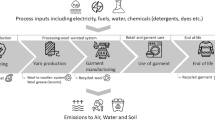Abstract
Volatile organic compounds (VOCs) are universally present in global atmospheric pollutants. These VOCs are responsible for photo chemical reaction in atmosphere leading to serious harmful effects on human health and environment. VOCs are produced from both natural and man-made sources and may have good commercial value if it can be utilized as alternate fuel. As per data from US EPA, 15% of total VOC emissions are generated from surface coating industry but VOC concentration and exhaust air volume varies to a great extent and is dependent on processes used by industry. Various technologies are available for abatement of VOCs. Physical, Chemical and Biological technologies are available to remove VOCs by either recovery or destruction with many advantages and limitations. With growing environmental awareness and considering the resource limitations of medium and small scale industries, requirement of a tool for selecting appropriate techno economically viable solution for removal of VOCs from industrial process exhaust is envisaged. The aim of the present study is to provide management a tool to determine the overall effect of implementation of VOC abatement technology on business performance and VOC emissions. The primary purpose of this work is to outline a methodology to rate various VOC abatement technologies with respect to the constraint of meeting current and foreseeable future regulatory requirements, operational flexibility and Over All Economics Parameters considering conservation of energy. In this paper an integrated approach has been proposed to select most appropriate abatement technology strategically. Analytical hierarchy process and Quality function deployment have been integrated for Techno-commercial evaluation. A case study on selection of VOC abatement technology for a leading aluminium foil surface coating, lamination and printing facility using this methodology is presented in this study.



Similar content being viewed by others
References
“Directive 2004/42/CE of the European Parliament and the Council” EUR-Lex. European Union Publications Office. Retrieved on 2016-05-02
J. Barbara, F. Pitts, J.N. Pitts, Atmospheric chemistry, Fundamentals and Experimental Techniques (Wiley, New York, 1986)
R. Duarte-Davidson et al., Benzene in the environment: an assessment of the potential risks to the health of the population. Occup. Environ. Med. 58, 2–13 (2001)
V. Muzyka et al., Alteration of heme metabolism in lymphocytes and metal content in blood plasma as markers of diesel fuels effects on human organism. Sci. Total Environ. 286, 73–81 (2002)
R.J. Delfino et al., Asthma symptoms in hispanic children and daily ambient exposures to toxic and criteria air pollutants. Environ. Health Perspect. 111, 647–656 (2002)
S.K. Chauhan et al., Recent trends of volatile organic compounds in ambient air and its health impacts: a review. Int. J. Technol. Res. Eng. 1, 667–678 (2014)
Clean Air Strategic Alliance, http://dwb.unl.edu/teacher/nsf/c09/c09links/www.casahome.org/volatile.htm. Accessed 04.02.2015
A. Guenther et al., A global model of natural volatile organic compound emissions. J. Geophys. Res. 100, 8873–8892 (1995)
A. Kansal, Sources and reactivity of NMHCs and VOCs in the atmosphere: a review. J. Hazard. Mater. 166, 17–26 (2009)
EPA, Volatile organic compounds (VOCs) (2012)
S.D. Piccot, J.J. Watson, J.W. Jones, A Global inventory of volatile organic compound emissions from anthropogenic sources. J. Geophys. Res. Atmos. 97, 9897–9912 (1991)
Central Pollution Control Board. Charter on Corporate Responsibility for Environmental Protection (CREP), Development of Minimal National Standards (MINAS) for Rubber products Manufacturing Industries, MINAS for Air Emission. http://cpcb.nic.in/crep.php. Accessed 03.02.2015
Environment Protection Act 1986, Ministry of Environment and Forests, New Delhi, amendment notification dated 9th November, 2012, for Proposed national emission standards for petrochemical plants
Dürr Systems GmbH, Environmental and Energy Systems/BOB 2, Cattalog, Technologies English (2010)
J.J. Spivey, Recovery of volatile organics from small industrial sources. Environ. Prog. 7, 31–40 (1988)
C.D. Cooper, F.C. Alley, Air pollution control: a design approach (Waveland Press, Prospect Heights, Ill, 2002), p. 738
E.C. Moretti, Reduce VOC and HAP emissions. Chem. Eng. Prog. 98, 30–40 (2002)
C.E. Baukal, Industrial Combustion Pollution and Control, vol. 27, Environmental Science and Pollution Control Series, 904 (Marcel Dekker, New York, 2004)
EPA, Air Pollution Control Cost Manual, 6th edn. (U.S. environmental protection agency, research triangle park, 2002)
M. Delhoménie, M. Heitz, Biofiltration of air. Crit. Rev. Biotechnol. 25, 53–72 (2005)
I. Calinescu et al., Hybrid technology with microwaves, electron beams and catalysts for VOCs removals. J. Microwave Power EE 43(3), 4–11 (2009)
T. Hakoda et al., An electron-beam irradiation/catalytic oxidation system for purification of aromatic hydrocarbons/air mixture under practical gas-flow condition. Ind. Eng. Chem. Res. 49, 5517–5522 (2010)
T. Hakoda et al., Oxidation of dimethyl sulfide in air using electron-beam irradiation, and enhancement of its oxidation via a MnO2 catalyst. Plasma Chem. Plasma Process. 29, 549–557 (2009)
K.J. Kim et al., Advanced oxidation of aromatic VOCs using a pilot system with electron beam–catalyst coupling. Radiat. Phys. Chem. 81, 561–565 (2012)
Y.S. Son et al., Decomposition of sulfur compounds by a radiolysis: III. A hybrid system and field application. Chem. Eng. J. 274, 9–16 (2015)
G.R. Parmar, N.N. Rao, Emerging control technologies for volatile organic compounds. Crit. Rev. Environ. Sci. Technol. 39(41), 41–78 (2009)
Y.S. Son, K.J. Kim, J.C. Kim, A review on VOCs control technology using electron beam. Asian J. Atmos. Environ. 4–2, 63–71 (2010)
F.I. Khan, A.K. Ghosal, Removal of volatile organic compounds from polluted air. J. Loss Prev. Process 13, 527–545 (2000)
Z. Shareefdeen, A. Singh, Biotechnology for Odour and Air Pollution Control (Springer, Germany, 2005), pp. 3–398
T.L. Saaty, The Analytic Hierarchy Process (McGraw-Hill, New York, 1980)
G. Rajesh, P. Malliga (2013) Supplier selection based on AHP QFD methodology. in International Conference on Design and Manufacturing. Paper no. 64, pp. 1283–1292
A. Bhattacharya et al., Supplier selection paradigm: an integrated hierarchical QFD methodology under multiple-criteria environment. Appl. Soft Comput. 10, 1013–1027 (2010)
J.A. Alonso, M.T. Lamata, Consistency in the analytic hierarchy process: a new approach. Int. J. Uncertain. 14(4), 445–459 (2006)
Author information
Authors and Affiliations
Corresponding author
Rights and permissions
About this article
Cite this article
Gupta, A.K., Modi, B.A. Selection of Sustainable Technology for VOC Abatement in an Industry: An Integrated AHP–QFD Approach. J. Inst. Eng. India Ser. A 99, 565–578 (2018). https://doi.org/10.1007/s40030-018-0294-7
Received:
Accepted:
Published:
Issue Date:
DOI: https://doi.org/10.1007/s40030-018-0294-7




